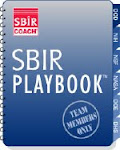Back in the "old days" when I was helping guide my own companies through the SBIR process, I discovered that all DOD SBIR program managers and administrators did not think alike. Most were very competent at what they did, which was to make sure that proposals turned into contracts, that the proper documents were in the proper places at the proper times, and that the contractual interests of the DOD were being met. Only very occasionally did we encounter an exceptional individual in the SBIR PM role who actually felt it was his or her job to motivate us to thinking about Phase III - the transition to commercialization. One such person was Linda Whittington in her role as a Navy SBIR Program Manager. We quickly became good friends and I learned to listen to her advice.
Linda retired from government service earlier this year and decided to launch her own SBIR-related consulting practice to utilize her vast knowledge of the DOD's technology transition process to help SBIR companies succeed in ensuring Phase III success. She sought me out for advice on some consultancy issues, and to open discussions about collaboration with SBIR Coach clients who were seeking to deploy their technology within the DOD.
We met up at the National SBIR Conference last month, and I took the opportunity to conduct an impromptu interview for the edification of my readers:
FP: Give me a capsule summary of your Navy SBIR Program Management experience.
LW: I started as an SBIR Program Manager at the Naval Supply Systems Command (NAVSUP) in 1985 and finished my government career as the SBIR PM at the Space and Naval Warfare Systems Command (SPAWAR) in May of this year.
FP: You saw many SBIR companies over the years. What characteristic did the successful ones share?
LW: The most successful companies were open to new ways of doing business, had a business focus and a well articulated commercialization strategy. After winning an award, they kept the lines of communication open with their technical points of contact and SBIR Program offices and were proactive in the transitioning effort of the technology.
FP: Getting to Phase III (commercialization) is the goal. How did you view your role in that?
LW: I felt it was my duty to spend the tax payers’ dollars wisely and give our war fighters the technology they required. Therefore, I made it my responsibility to make other potential users inside DOD aware of technical efforts that we had funded and encourage them to leverage this technology into deployment. To make the offer even more appealing, I also offered procurement assistance to facilitate the Phase III effort for multiple users. This saved both time and money.
FP: What did you do differently from other Navy and DOD SBIR Program Managers?
LW: My goal for successful SBIR efforts was to create a win-win solution for all players. When faced with challenges that threatened that result I was tenacious in finding a solution that allowed us to move forward. More often than not, this meant taking risks, thinking out of the box and overcoming internal DOD cultural barriers. As an example, there was a requirement for an anti-terrorism effort that clearly would require more than one technology to resolve. I took the novel approach of putting together a consortium of five SBIR companies that, working together, successfully responded to the anti-terrorism requirement. DOD doesn't normally operate this way and we had significant management and procurement challenges to overcome.
FP: What advice would you give to SBIR awardees for them to be more likely to succeed at commercialization?
LW: Make your presentations high level, clear and concise. Be proactive and tenacious. Follow through and be open to new ways of doing business.
Linda recently gave me a T-Shirt that proclaims: "Without deviation from the norm ... Progress is not possible." (A quote from, of all people, Frank Zappa!) Linda's SBIR philosophy was, and continues to be, exactly this. You can see what Linda's consulting business is all about on her website: www.WhittingtonSolutions.com.
Rick Shindell sent out a new SBIR Insider Update yesterday. Here are a few of the highlights in headline form:
> Mary Landrieu (D-LA) to succeed John Kerry as Chair of the SBE Committee in the Senate
> SBIR Program Directors Vinny Schaper (DHS) and Steve Guilfoos (USAF) to retire soon
> SBA posts "Affiliation and Size Standard Rules" discussion on their website
> NIST TIP Program call for White Papers on areas of "critical national need"
> New Air Force BAA released
See the details of these items, and others, at The SBIR Gateway's Insider Newsletter page, or email me for a copy.
SBIR Coach Newsletters are now archived on the Web and available for download from my website. Subscribe for email delivery by clicking the button on the left.
Please permit me to wish everyone a very warm and fulfilling Christmas or Hanukkah celebration, and may all of us successfully withstand the the current economic turmoil and experience a prosperous New Year.
.
Twenty Years of Small Biz Survival
6 days ago





 Join Email List
Join Email List




No comments:
Post a Comment